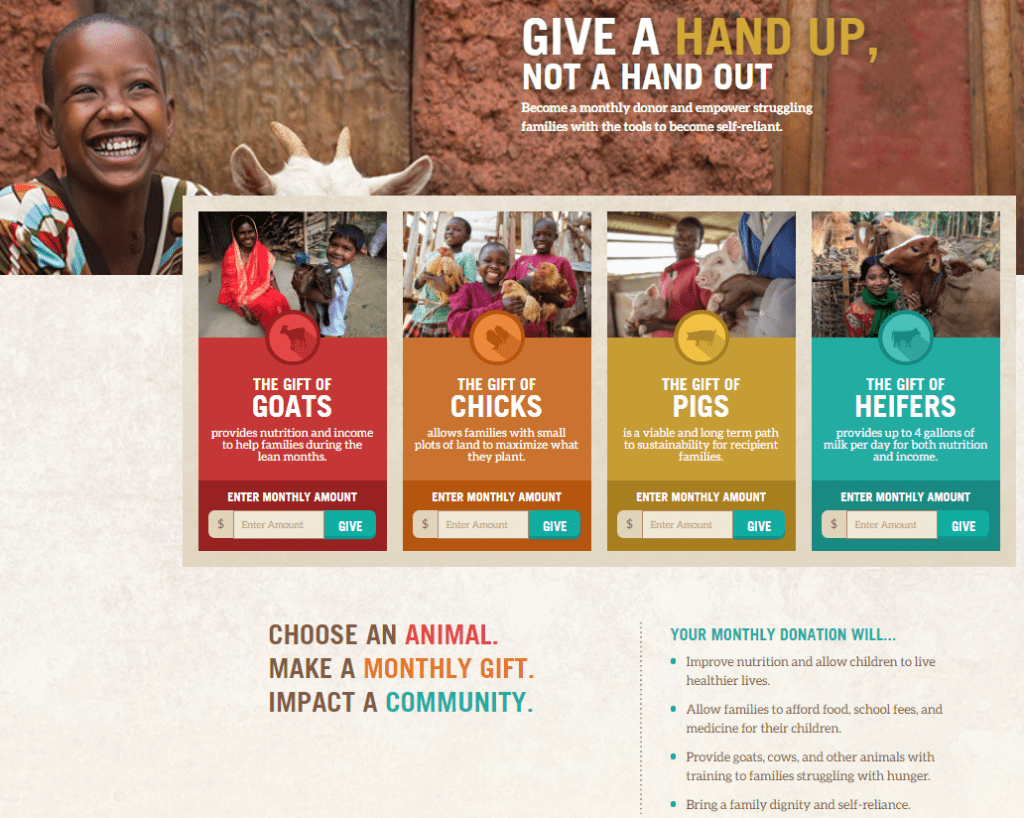 Do you have monthly donors, or a monthly donor program?
Do you have monthly donors, or a monthly donor program?
If you don’t have a program, you’re likely leaving monthly donors on the table.
This is hurting your bottom line because, on balance, the net value of a monthly donor to you is more than that of a one-time donor.
So let’s look at how to turn your handful of monthly donors into a full-fledged program.
1. Begin with Proactive Strategies
If what you have right now is simply a checkoff box on your remit piece or donation landing page, you’ve got a passive strategy.
In other words, if donors don’t know why you want them to give a monthly gift there’s nothing to persuade them to check this box. Try to get inside the donor’s head and imagine what they’re thinking. It could be any of the following:
- That checkoff box is probably for small donors.
- Are they asking me to give what I give annually every month? That’s too much.
- I imagine that’s a lot of trouble for them to administer. I’ll make it easy and give my whole annual gift now.
- Or… ?
The point is your donor shouldn’t have to wonder if you’ll give them a thumbs up or thumbs down if they choose this option. Not only do you have to clarify why you’re asking them to make a monthly gift; you also must give them multiple opportunities to make their gift this way.
The best proactive strategy is to make folks feel they are joining a community of do-gooders.
2. Get With the (Monthly Giving) Program
What makes monthly donors so special?
- For you, it means a consistent reliable stream of philanthropic income.
- For donors, it means an ongoing opportunity to feel good about their engagement with your nonprofit.
You’ll want to wrap these two characteristics into your monthly giving program.
The first entails getting buy-in from your leadership that a monthly giving program should be a strategic priority. Why? To begin with, research shows it increases donor retention from an average of 46% to 80 to 90%. That’s huge! You’re also able to multiply the value of every donor. For example, a $100 donor can be asked to make a $10 monthly gift. This increases their value to you by $20/year. But it doesn’t seem like a heavy lift. Similarly, a $500 donor can be asked to make a $50 monthly gift, increasing their annual value to you by $100. This is equivalent to getting a new $100 donor, but it’s much easier. [Get more reasons to start a monthly giving program here.]
The second involves persuading your donors this is convenient and useful — from both your perspectives. Donors don’t have to write a large check; the money is simply charged to their credit card in manageable amounts at regular intervals. You don’t have to worry if you’ll have money 7 months from now; this helps you to budget and plan. Monthly donors can rest assured their gift is helping all year long and not just at a single point in time.
3. Build Key Elements of Your Monthly Giving Program
To facilitate monthly giving, you’ll want to put policies and procedures in place. When I began in fundraising, this was a difficult proposition. Today, however, there are all sorts of subscription-based services, online giving programs and multiple digital tools to expedite monthly giving (see here and here for some options; also check out some of my sponsors, below). In fact, chances are that monthly giving is already built-in to your donor database or CRM – so ask your support staff what you’ve got and/or what other programs may integrate well with your existing service.,
Put someone in charge. I can almost guarantee you this will fall to the back burner if you don’t designate a specific staff person to be responsible for development, implementation and oversight of this program. Make sure they have a strategic work plan with deadlines, and hold their feet to the fire to meet established objectives.
I like to brand monthly giving programs with a catchy name and clear case for support. When I worked at a food bank we called it the “Meal of the Month” club. Donors liked knowing they were feeding somebody every single month of the year, and it enabled us to communicate with them regularly to remind them of the benefits of their philanthropy. Make-A-Wish calls their program the “Wishmaker Club” so members can feel they’re not just granting one wish, but maybe a dozen throughout the course of the year. Her’s an example of a branded web page from Heifer International that makes a compelling case for monthly giving:

[For 10 strategies to create a full-fledged monthly giving program click here.]
4. Target Prospects Most Likely to Join
I don’t usually recommend asking major donors to become monthly givers. For them, you really want to focus on the specific purpose of their gift, the specific amount you want them to invest, and what this will specifically accomplish. After they’ve agreed to make the gift, you can of course let them know they can pay monthly if they prefer. With these types of supporters, monthly giving is merely a convenience.
Let’s talk about the donors and prospects for whom monthly giving is an upgrade strategy. Your most likely targets are:
- Donors who make multiple gifts throughout the year (but who give less cumulatively than your major gift or leadership gift society level)
- Donors who make small single gifts (e.g., $100 or under)
- Donors who make mid-level single gifts, and who are not major gift prospects (e.g., under $1,000)
- Donors who give by credit card
- Supporters make other purchases (e.g., tickets; memberships; auction purchases; thrift store; swag, etc.) but who have not yet become donors
- Certain demographic groups (e.g., Seniors on fixed incomes; Millennials just getting a start in life)
For targeted monthly giving prospects, I recommend communicating with a targeted monthly giving ask. It always makes sense to match your appeal with your audience, rather than sending a ‘one size fits most’ to everyone.
The whole purpose of this appeal is to invite prospects to join your monthly giving club. It’s not simply an add-on to your regular appeal. There are a number of ways to accomplish this goal. You can send a special monthly giving appeal letter. You can send a special monthly giving appeal email. You can run a targeted monthly giving staffed by your volunteers. You can have a monthly giving drop-down on your website menu. You can have a monthly giving landing page on your website that makes the case for support and offers options at different giving levels. You can even pick a month where you take over your homepage with a monthly giving campaign that links to the monthly giving landing page when donors click on it.
5. Clarify, Don’t Bury, the Monthly Giving Option
If you’re not yet ready to send a targeted monthly giving appeal, at least make sure the monthly giving option isn’t hard for donors to find. Or confusing for them to use. Too often, it’s buried in the fine print where it goes largely unnoticed. Especially if everything else in the package is leading your prospect to consider a one-time gift.
Be direct, and get specific, with your monthly giving ask. Don’t ask the donor to consider a $500 gift and then pair this with a remit piece that simply says “One time?” ”Monthly? This makes the donor have to figure out how much $500 is divided by 12. Or wonder if you mean for them to give $500 every month. They’ll end up having to think, and this thinking and wondering may stop them dead in their tracks. You don’t want that! Because if they put your appeal aside to come back to later, more often than not, later never comes.
There are many excellent ways to include a monthly giving tick-off box in your appeal. Check out these suggested by monthly giving guru, Erica Waasdorp. My favorite is the remit from Heifer that clarifies why you might wish to consider the monthly gift and become what they call a “worker bee.” It takes a passive tick-box to the active level by clarifying you’re not just making a single gift of honeybees to a family; rather, you’re working throughout the year to provide multiple gifts.
[Check out some additional ways to make monthly giving easier here.]
6. Ask Multiple Times
Now were back to being proactive.
Think abundantly about when and where you ask.
Just like you should ask donors to give single gifts multiple times a year, so should you offer monthly giving options more than once. Face it. People are busy. The first time you end up in folk’s mailbox may not be the best time for them. Don’t put all your eggs in one basket. Most charities simply don’t mail frequently enough.
You also shouldn’t make all your asks using the same channel. People give differently. You’ll have the most success if you meet them where they are. When they are ready. So also ask in your newsletter. Your blog. Your social media. Include an option in your thank you welcome package. Begin to think creatively about ways you can introduce this opportunity to your supporters.
SUMMARY
Chances are you already have some sort of monthly giving initiative. But… is it the best it can be? Could it do more heavy lifting for you? Could it help you renew donors and sustain greater loyalty? Could it be a magical upgrading strategy that boosts the amount of support received from current donors?
The answer is YES!
So… What are you waiting for? Add this to your development strategic plan for the coming year and enjoy the fruits of your labor.
Learn How to Retain More Donors
 Get my Donor Retention and Gratitude Playbook. You’ll get 6 separate companion guides (at a bargain if you buy the bundle)! Or you can purchase them individually. Taken together, they are a complete Donor Retention ‘Bible’ — everything you need to raise more money by keeping your current donors and increasing their average gift! It’s filled with hands-on, practical information garnered from my 30+ years working in the nonprofit trenches. This stuff works! The Attitude of Gratitude Donor Guide alone is 98 full pages, with lots of ready-to-use samples and templates. You’ll save almost a third if you buy them all together. Grab your bargain bundle here. I promise if you read these E-Guides, and put the recommended strategies into action, you’ll keep more donors and raise more dollars.
Get my Donor Retention and Gratitude Playbook. You’ll get 6 separate companion guides (at a bargain if you buy the bundle)! Or you can purchase them individually. Taken together, they are a complete Donor Retention ‘Bible’ — everything you need to raise more money by keeping your current donors and increasing their average gift! It’s filled with hands-on, practical information garnered from my 30+ years working in the nonprofit trenches. This stuff works! The Attitude of Gratitude Donor Guide alone is 98 full pages, with lots of ready-to-use samples and templates. You’ll save almost a third if you buy them all together. Grab your bargain bundle here. I promise if you read these E-Guides, and put the recommended strategies into action, you’ll keep more donors and raise more dollars.
As with all Clairification products, this comes with a 30-day, no-questions-asked, 100% refund guarantee. You can’t lose.
Image by Henning Westerkamp from Pixabay





Great information and very thorough. thank you!